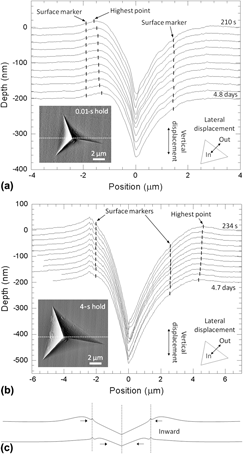Crossref Citations
This article has been cited by the following publications. This list is generated based on data provided by
Crossref.
Jakes, Joseph E.
Lakes, Rod S.
and
Stone, Don S.
2012.
Broadband nanoindentation of glassy polymers: Part II. Viscoplasticity.
Journal of Materials Research,
Vol. 27,
Issue. 2,
p.
475.
Ago, Mariko
Jakes, Joseph E.
and
Rojas, Orlando J.
2013.
Thermomechanical Properties of Lignin-Based Electrospun Nanofibers and Films Reinforced with Cellulose Nanocrystals: A Dynamic Mechanical and Nanoindentation Study.
ACS Applied Materials & Interfaces,
Vol. 5,
Issue. 22,
p.
11768.
Cohen, Sidney R
and
Kalfon-Cohen, Estelle
2013.
Dynamic nanoindentation by instrumented nanoindentation and force microscopy: a comparative review.
Beilstein Journal of Nanotechnology,
Vol. 4,
Issue. ,
p.
815.
Ren, Juan
and
Zou, Qingze
2014.
A Control-Based Approach to Accurate Nanoindentation Quantification in Broadband Nanomechanical Measurement Using Scanning Probe Microscope.
IEEE Transactions on Nanotechnology,
Vol. 13,
Issue. 1,
p.
46.
Shirazi, Reyhaneh Neghabat
Aldabbagh, Fawaz
Erxleben, Andrea
Rochev, Yury
and
McHugh, Peter
2014.
Nanomechanical properties of poly(lactic-co-glycolic) acid film during degradation.
Acta Biomaterialia,
Vol. 10,
Issue. 11,
p.
4695.
Lorenzo, V.
de la Orden, M.U.
Muñoz, C.
Serrano, C.
and
Martínez Urreaga, J.
2014.
Mechanical characterisation of virgin and recovered polycarbonate based nanocomposites by means of Depth Sensing Indentation measurements.
European Polymer Journal,
Vol. 55,
Issue. ,
p.
1.
Herbert, Erik G.
Sudharshan Phani, P.
and
Johanns, Kurt E.
2015.
Nanoindentation of viscoelastic solids: A critical assessment of experimental methods.
Current Opinion in Solid State and Materials Science,
Vol. 19,
Issue. 6,
p.
334.
Wang, Xinzhou
Li, Yanjun
Wang, Siqun
Deng, Yuhe
Xing, Dong
and
He, Shuangshuang
2015.
Investigating the nanomechanical behavior of thermosetting polymers using high-temperature nanoindentation.
European Polymer Journal,
Vol. 70,
Issue. ,
p.
360.
Shirazi, Reyhaneh Neghabat
Rochev, Yury
and
McHugh, Peter
2016.
Nanoindentation of solvent-cast and compression-moulded poly(lactic-co-glycolic acid) to determine elastic modulus and hardness.
Polymer Testing,
Vol. 50,
Issue. ,
p.
111.
Hunt, Christopher G.
Frihart, Charles R.
Dunky, Manfred
and
Rohumaa, Anti
2019.
Progress in Adhesion and Adhesives.
p.
353.
Li, Z
Gao, S
Brand, U
Hiller, K
and
Wolff, H
2020.
A MEMS nanoindenter with an integrated AFM cantilever gripper for nanomechanical characterization of compliant materials.
Nanotechnology,
Vol. 31,
Issue. 30,
p.
305502.
Jakes, Joseph E.
and
Stone, Donald S.
2021.
Best Practices for Quasistatic Berkovich Nanoindentation of Wood Cell Walls.
Forests,
Vol. 12,
Issue. 12,
p.
1696.
Fulco, Sage
Wolf, Sarah
Jakes, Joseph E.
Fakhraai, Zahra
and
Turner, Kevin T.
2021.
Effect of surface detection error due to elastic–plastic deformation on nanoindentation measurements of elastic modulus and hardness.
Journal of Materials Research,
Vol. 36,
Issue. 11,
p.
2176.
Cao, Dongyang
Malakooti, Sadeq
Kulkarni, Vijay N.
Ren, Yao
and
Lu, Hongbing
2021.
Nanoindentation measurement of core–skin interphase viscoelastic properties in a sandwich glass composite.
Mechanics of Time-Dependent Materials,
Vol. 25,
Issue. 3,
p.
353.
Abba, M. T.
and
Kalidindi, S. R.
2022.
Protocols for studying the time-dependent mechanical response of viscoelastic materials using spherical indentation stress-strain curves.
Mechanics of Time-Dependent Materials,
Vol. 26,
Issue. 1,
p.
1.
Erazo, Oswaldo
Jakes, Joseph E.
Plaza, Nayomi Z.
Vergara-Figueroa, Judith
Valenzuela, Paulina
and
Gacitúa, William
2023.
Quasistatic and Dynamic Nanoindentation Measurements of Pinus radiata D. Don S2 and CCML Cell Wall Layers.
Forests,
Vol. 14,
Issue. 9,
p.
1900.
Christoefl, P.
Jakes, J. E.
Geier, J.
Pinter, G.
Oreski, G.
Stone, D.
and
Teichert, C.
2023.
Improved nanoindentation methods for polymer based multilayer film cross-sections.
p.
1.
Jakes, Joseph E.
O’dell, Jane
and
Stone, Donald S.
2024.
Viscoelastic Moduli and Path-Dependent Hardness Across Four Decades of Timescale in Semicrystalline Polymers from Berkovich Nanoindentation.
JOM,
Vol. 76,
Issue. 6,
p.
2956.
Stone, D. S.
Jakes, J. E.
and
Elmustafa, A. A.
2024.
A Well-Posed Definition for Plastic Strain Rate in Indentation.
JOM,
Vol. 76,
Issue. 6,
p.
2946.





